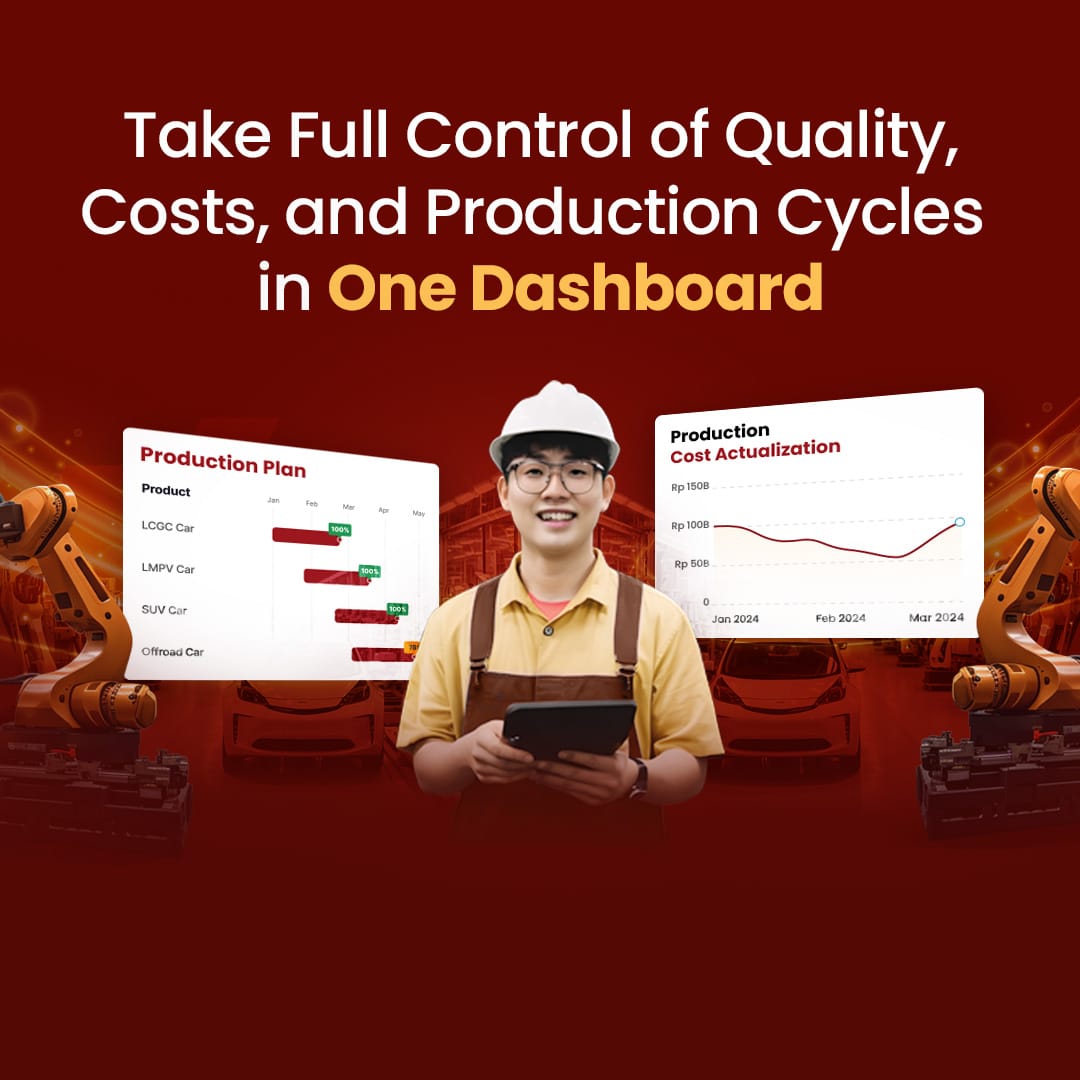Lean manufacturing, often known as lean production, is a methodology that businesses in a range of industries can implement. It aims to eliminate waste, which is one of the worst things that can happen to any business. If you do not fully utilize all of your resources, you will lose efficiency and production will suffer.
Of course, the manufacturing business generates a lot of waste. Whether it’s inactive employees or non-recyclable or reused materials, the final result is the same: productivity suffers. Therefore, a complete manufacturing ERP system is needed to increase the productivity and profitability of the manufacturing business.
The concept of lean as a management strategy originated from the emphasis on reducing waste and improving the manufacturing process. Moreover, it can provide advantages such as shorter lead times, lower operational costs, and higher product quality.
Learn strategies such as value stream mapping or just-in-time delivery can be used for improving processes, managing inventory, and managing supply chains. The use of cloud-based manufacturing software from HashMicro helps you improve the efficiency of your business processes. As a result, it will make your business more successful and competitive in any market.

Table of Content:
Table of Content
What is Lean Manufacturing
Lean manufacturing is a production system that focuses on reducing waste, creating customer value, and seeking continuous process improvement. Lean manufacturing philosophy was first developed by Toyota in the Toyota Production System (TPS) which revolutionized the company’s manufacturing process. The term Lean manufacturing refers to the application of Lean practices, principles, and tools to the development of physical products.
Lean manufacturing provides a systematic strategy for reducing waste in production processes while improving productivity and quality. Many manufacturers are using these principles to eliminate waste, optimize processes, cut costs, boost innovation, and so on, with the help of integrated manufacturing software.
The ultimate goal of implementing lean manufacturing is not simply to eliminate waste, but also to sustainably deliver value to the customer. To achieve that goal, the use of comprehensive manufacturing software can be beneficial to your company.
Lean manufacturing defines waste as anything that doesn’t add value to the customer. The types of waste include processes, activities, products, or services. Anything that requires an investment of time, money, and talent that does not create value for the customer is a waste. Removing these inefficiencies should streamline services, reduce costs, and ultimately provide savings for a specific product or service through the supply chain to the customer.
Lean Manufacturing Principles
The following are the five lean management principles to optimize lean manufacturing systems:
Define Value
Before you can start analyzing and reducing waste, you must first determine what is valuable to the customer. Value is defined as a customer’s willingness to pay for something. It’s important to find the customer’s actual or latent needs. Sometimes customers may not know what they want, which is very common when it comes to new products or technologies. Once the consumer has defined what is important to them, you may create a product that contains only what is essential.
Many methods, such as interviews, surveys, demographic data, and site analytics, can assist you in analyzing and discovering what customers value. Using these qualitative and quantitative methods, you may learn what customers want, how they want the product or service delivered, and the price they can afford.
Value Stream Mapping
The second Lean principle is identifying and mapping the value stream. A value stream map allows managers to visualize each step in the production process to identify waste and opportunities for improvement. The term “value stream” refers to the process it takes to turn a customer request into a deliverable piece of value. Activities that do not add value to the end customer are considered waste.
By reducing and eliminating unnecessary processes or steps, you can ensure that customers are getting exactly what they want while at the same time reducing the cost of producing that product or service. The purpose of value stream mapping is to be able to analyze the overall process and each of its steps, to be able to design out (to borrow from TPS) overburden, inconsistency, and waste.
Create Flow
After removing the wastes from the value stream, the following action is to ensure that the flow of the remaining steps runs smoothly without interruptions or delays. There are several strategies to ensure that value-adding activities flow smoothly. These include: breaking down the steps, reconfiguring production measures, leveling workloads, creating cross-functional departments, and training employees to be multi-skilled and adaptive. One of the goals of lean manufacturing is process improvement. That is because once you improve the steps in the value stream, you can reduce your production lead time.
Pull System
Implementing a demand-based, or (pull) manufacturing system is key to effectively managing capacity. In a pull manufacturing system, Inventory is considered one of the biggest wastes. Pull systems allow “just-in-time” delivery of work. Unlike other work methods that allow for an unlimited amount of work at once. A pull system enables everyone at a specific organizational level to focus on one thing (or just a few things) at one time.
The goal of a pull-based system is to limit inventory and work-in-process (WIP) items while ensuring that the requisite materials and information are available for a smooth flow of work. Pull-based systems are always created from the needs of the end customers. By following the value stream and working backward through the production system, you can ensure that the products produced will be able to satisfy the needs of customers.
Continuous Improvement
This lean principle consists of constantly using lean techniques like value stream mapping to find and eliminate waste. An organization-wide commitment to continuous improvement is essential for sustainable success with Lean manufacturing. At its core, Lean is continuous improvement – it’s improving products and processes while eliminating redundant, excessive, or inefficient activities.
Continuous improvement can be viewed as a formal practice or an informal set of guidelines – but it must be well integrated into the culture of an organization to make a meaningful and lasting difference.
Lean Manufacturing Tools
You’ll need a set of lean manufacturing tools to assist you in discovering and reducing waste when you implement lean principles in your manufacturing process. Overburdening and uneven workloads are two factors that can lead to waste this is the use of lean manufacturing tools. Waste elimination improves quality and production time while lowering costs in any industrial system.
Some of those lean management tools include:
- SMED (single-minute exchange of die, which is a fast way to move from one manufacturing process to another)
- Value stream mapping (A value stream map allows managers to visualize each step of the manufacturing process to identify process improvement opportunities)
- 5S (a workplace organization methodology)
- Kanban boards (visualizes workflow)
- Poka-yoke (error-proofing)
- Total productive maintenance (improves the integrity and quality of manufacturing process)
- Rank order clustering (production flow analysis)
- Single-point scheduling
- Redesigning working cells
- Multi-process handling
- Control charts (for checking workloads)
Another way to approach lean manufacturing is timely manufacturing or the Toyota Way, which was created by Toyota for its famous manufacturing system (TPS). The goal here is to improve the workflow to eliminate inefficiencies. Both approaches have the same aims, but the ways of achieving them are slightly different.
Lean Manufacturing Benefits
Lean project management requires reducing or eliminating waste. However, the advantages of lean manufacturing vary depending on who asks. Some argue that the modifications are only intended to boost consumer value and contentment, while others argue that it is improving corporation profit. Here are a few common aims:
Improve Quality
Companies must adapt to new customer desires and needs in order to remain competitive. As a result, processes must be structured to satisfy customer expectations and requirements. Adopting full-quality management may make high-quality improvement a priority.
Inventory Management
Lean manufacturing removes excess inventory through the use of just-in-time production, which lowers costs and prevents production difficulties. You can also use inventory management software to ensure optimal inventory control and optimize stock management.
Process Improvement
The “continuous improvement” lean principle ensures that lean production processes are continually improving. This requires the use of value stream mapping.
Eliminate Waste
Waste has a negative impact on prices, deadlines, and resources. It reduces a product or service’s value without contributing anything to it. A lean manufacturing strategy can deliver better products at cheaper costs by removing waste.
Reduce Time
As the old phrase goes, time is money, and wasting time is a waste of money.
This is especially true in manufacturing. By increasing efficiency, you can reduce the time it takes to start and conclude a project. Learn and put some time management strategies into practice.
Reduce Total Costs
When a business does not waste time, materials, or staff on unnecessary tasks, it saves money. Overproduction increases the cost of storage and warehousing. The first step in understanding cost management is to know the triple constraint.
Types of Waste in the Lean Manufacturing Process
Unnecessary transportation
Waste of transportation occurs due to poor organization of the workplace that requires the activity of moving goods from one place to another. For example, the location of a warehouse is far from the production site. Unnecessary transportation of workers, tools, products, or equipment is a waste that we must reduce through optimization of the production layout.
Excess inventory
Waste of inventory occurs due to finished goods, semi-finished goods, and excessive raw materials at all stages of production so that it requires storage. It also includes large capital, the person overseeing it, and the documentation work (paperwork). Excess inventory can cause a variety of issues, including delayed detection of defective products and longer lead times in the manufacturing process, to name a few.
Unnecessary motion of people, equipment, or machinery
This waste is reduced by using scientific management strategies to optimize the movements of people, equipment, and machines during the manufacturing process.
Waiting (Idle Workers or Idle Equipment)
This condition can occur due to machine damage, late supply of materials or equipment, loss of work tools, or waiting for certain decisions or information.
Overproduction
Overproduction leads to excess inventory and other issues in the manufacturing process. This waste occurs due to overproduction in the form of finished goods and semi-finished goods but there are no orders from customers. Some of the reasons for overproduction include the time of the old engine set up, low quality, or the thought of “just in case” there is a need for it.
Over-processing
Not every process can provide added value for the products produced or for customers. Processes that do not provide added value are wasteful or excessive. This waste consists in adding components or features to a product that are not required by the customer, which makes them unnecessary.
Defects
Having defective products it’s a waste that can affect customer satisfaction and increase costs. This waste occurs because of poor quality or defects that require repair. This will lead to additional costs in the form of labor costs, components used in repairs, and other costs.
Conclusion
Implementing Lean manufacturing concepts can change the way your business delivers value by fostering a long-term culture of efficiency and improvement.
If you’re in the market for reducing waste, improving efficiencies, and adding to your productivity through lean management, you must use modern integrated Manufacturing software from HashMicro.
Hash Manufacturing Automation is the perfect software to assist you in making the most of your Lean journey by providing your company with the tools it needs to collaborate, assess performance, and optimize processes to support work as it flows through the value stream.
Simply contact our professional consultants here to learn more about a cloud-based ERP software that will benefit your business significantly through a free demo.







































